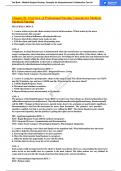Exam (elaborations)
MEDICAL-SURGICAL NURSING CONCEPTS FOR INTERPROFESSIONAL COLLABORATIVE CARE 9TH EDITION BY IGNATAVICIUS AND WORKMAN TEST BANK
- Course
- Institution
- Book
Awarded second place in the 2018 AJN Book of the Year Awards in Medical-Surgical Nursing! Healthcare is evolving at an incredible pace and with it, the roles and responsibilities of the medical-surgical nurse. Ensure you are fully equipped to thrive and adapt in this ever-changing nursing enviro...
[Show more]




